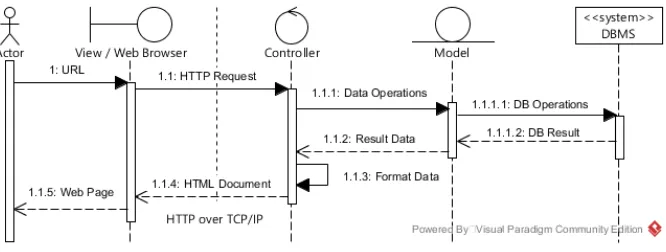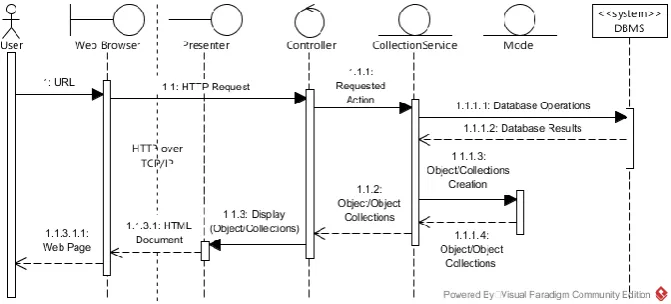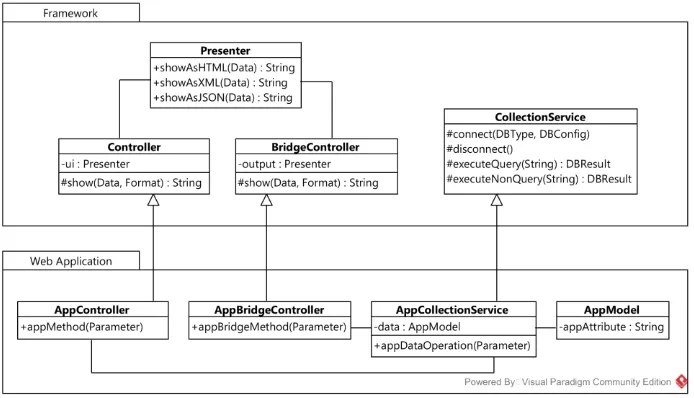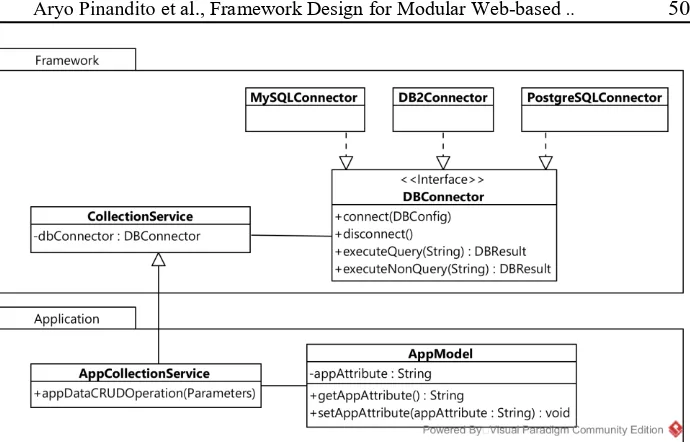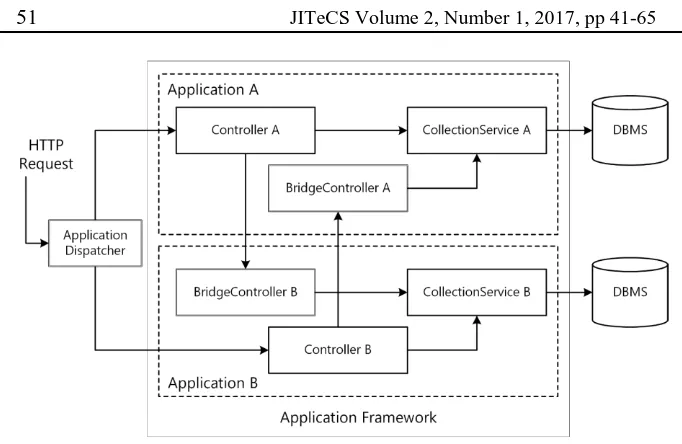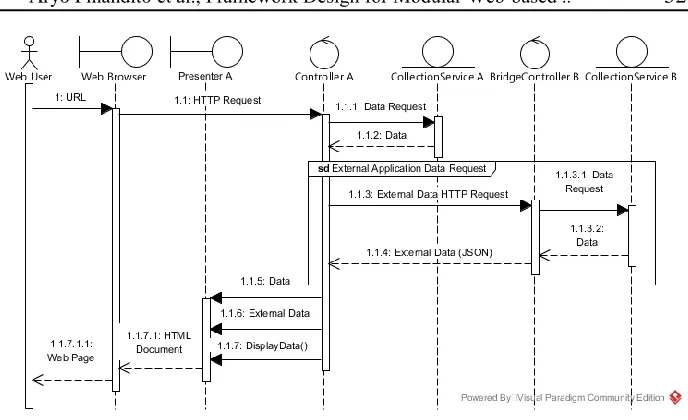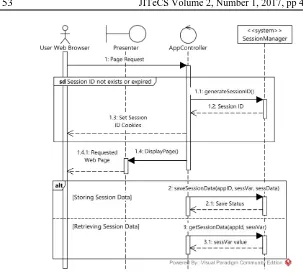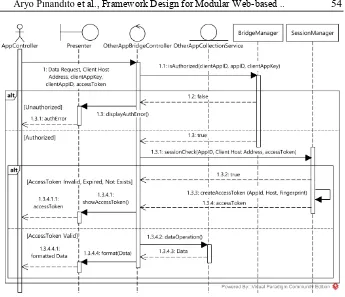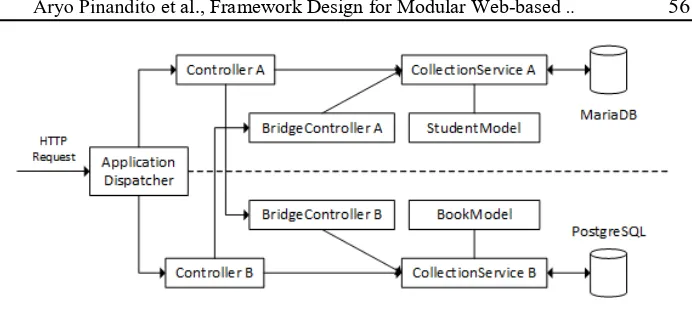Journal Homepage: www.jitecs.ub.ac.id
Framework Design for Modular Web-based Application
Using Model-CollectionService-Controller-Presenter
(MCCP) Pattern
Aryo Pinandito1, Ferdika Bagus Pristiawan Permana2, Rizal Setya Perdana3
1 Information System, Computer Science Faculty, 2 Information and Communication Technology Division,
3 Informatics Engineering, Computer Science Faculty,
Universitas Brawijaya, Malang, Jawa Timur, Indonesia {aryo, ferdika.bagus, rizalespe}@ub.ac.id
Received 31 January 2017; accepted 22 June 2017
Abstract. Design pattern become an important thing in assisting the development of web-based application and in handling the problem of dynamically changing of organization structure and problem domain. Model-View-Controller (MVC) is a well-known design pattern in web-based application development due to its nature in the separation of an application into several parts, hence easy to reuse and maintain. However, integration of such design pattern requires several improvements in the design phase of information system development since it handles business process choreography and integration between application. Modification the interaction style of objects in a particular design pattern become a challenging problem. An application framework that employ Model-CollectionService-Controller-Presenter (MCCP) design pattern, which is resulting from modification of MVC design pattern, was proposed. The proposed framework also allows different applications to run simultaneously and provides inter-application data exchange mechanism to improve the data communication process between applications. The MCCP design pattern application framework shows that the application framework requires 51% less memory resources than another similar MVC framework such as CodeIgniter and cope the flexibility problem in data format presentations by providing a Presenter in the designed framework.
1.
Introduction
Aryo Pinandito et al., Framework Design for Modular Web-based ..
42
applications or computer programs were running in their own operating environment to meet organization or specific requirements of business processes.
In order to accommodate the changing dynamics of user requirements in a currently running business processes, web-based applications are more appropriate to be implemented than native desktop applications as users are not required to be manually install or update the application manually. In a web-based application, any changes made on the application server will be directly reflected and distributed to all active-users. As long as application users are using web-application using compatible web browsers there will be no issues in user's computer platform. Application developers will have full control in the distribution of developed application even though web-based application has limitation in programming code optimization, bigger overhead, and less control in utilizing computation resources of user computer than native desktop applications [1].
It is very common that applications need to be able to communicate with each other. There are cases that one application requires data from the output of the other application. The need of data integrations and business process choreography between units in organization urge the flexibility, ease of use, ease of access, and ease of development of information system in the future. The difference between applications data format, storage, and running environment make data integration between applications becomes difficult.
Although web-based applications in an information system are offering several more conveniences over native desktop applications, there are several other problems faced in a software development life cycle mainly in data integration problem between applications, user authentication, user authorization towards functionalities and data access among different applications. People who have several roles in organization business process may have different authorization towards different applications. That kind of users are often had to login and logout between applications in order to complete their tasks that needs to be performed in different applications.
One of popular web-application design pattern is Model-View-Controller (MVC). MVC become very popular since several web application development frameworks were built on this pattern [3A]. In MVC design pattern, an application is divided into three parts, i.e. application logic as Controller, user interface as View, and application domain as Model. In MVC, reuse of programming code led to reduction in application code complexity, increasing code flexibility, and reduce coupling in application code components [4A]. However, MVC design pattern does not solve problem to be solved by programming code. MVC does help to write application programming code that is flexible, decoupled, easy to understand, and easy to reuse in another part of code [4A]. This research proposes an enhanced web application development framework based on MVC design pattern that allow application developers to develop multiple web-based applications in a single application framework setup in order to simplify the development process of applications and process of integrating the applications. The application framework also provides data communication between applications that allow application to access other application data. Several performance measurements were conducted to the framework in order to describe its performance characteristics compared to another similar web application framework.
2.
Related Work
There are many choices of use framework in web development. Among of them, there is Laravel which is recently being very popular web application framework among web developers, Zend Framework which is devoted to enterprise scale web applications, Struts, JSF, Ruby on Rails, Grails, CakePHP, Django, Lift Framework, Catalyst, and many more. Every framework is offering their own advantages and disadvantages in particular aspects. Several issues faced by web application frameworks were memory management issues, complex design pattern, execution performance, scalability, maintainability, reusability, suitability, fitness for a particular purpose, and application modularity problem. Thus, leading software engineers and researchers to creatively propose solutions to resolve the issues.
Dragos-Paul Pop [5A] proposed a solid framework that is claimed to be able to reduce web application development times drastically, thus allowing web application developers to focus on application specific tasks rather than wasting more time in trying to implement or extend well-known patterns and practices. However, the performance of rendering engine and support in several NoSQL systems were require improvements. Several existing frameworks have complex design patterns whereas the complexity of framework and application design were not always comparable to its performance. Some files were included during script execution. To overcome this problem, Umi Sa’adah [6] uses a simple design pattern, namely Singleton and namespace or package in Java. This research yields a lightweight PHP framework, with Singleton design pattern, namespace, AJAX, and multiple databases.
Aryo Pinandito et al., Framework Design for Modular Web-based ..
44
an easy and rapid application development, reusable code, and development flexibility for the developers.
Application development best practices are activities, technical or important issues, which are identified by users in a specific context, that render excellent services and expected to achieve similar results in similar situations. Every framework has its own best practices whose aim is to facilitate the development of web applications. However, there are no current comparative analysis that identifies best practices in web application frameworks. María del Pilar Salas-Zárate [8A] identifies a set of best practices for web frameworks. Afterwards, these best practices were analyzed and discussed in terms of developing Lift-based web applications. The identification of these best practices would allow developers to construct more interactive and efficient Lift-based web applications, integrating features found in Web 2.0 technologies with less effort thus exploiting framework's benefits.
3.
Literature Review
3.1 Model-View-Controller (MVC)
Web-based Model-View-Controller (MVC) is a well-known design pattern used to develop a web based application that separates application into three parts based on business logic (Model), rendering output (View), and glue between Model and View (Controller). Reusing a Model by several Views is one of major advantages of MVC design pattern. Therefore, it is possible that an equal data to have multiple different presentations. MVC design pattern encourages developers to partition their application code into modular Model, View, and Controller. Therefore, application codes are relatively easy to reuse, maintain, and developed further.
Fig. 1. Sequence diagram of MVC design pattern in web-based application.
components reuse and provide good design consistency [9A]. Developing a web-based application using MVC design pattern allows easy maintenance and the possibility to an independent development by several different programmers [10A].
More or less, MVC design pattern is a direct translation to Boundary-Control-Entity objects in object-oriented analysis and design. In MVC design pattern, attributes and behaviors of entities or objects were translated into Models. Entities or objects which handled in a particular operation might be a single object or a collection of objects. Behaviors related to a single object and a collection of object might be different and may cause process ambiguity. Several behaviors might be applicable for a single object but not for a collection of object and vice versa. Therefore, this pattern could be improved by separating models that process singular object and a collection of object.
3.2 Model-CollectionService-Controller-Presenter (MCCP)
According to sequence diagram of MVC design pattern as depicted in Figure 1, a Model is responsible to communicate with Database Management System (DBMS) server and fetches data result from database that is required by business processes logic or requested by users. The implementation of MVC design pattern in a web application development still faces a problem related to the Model functionality. Analysis phase in software development yields class diagrams from the problem domain analysis which will be translated into Model objects. Single or set of database result object, which implemented in same object of Model, may difficult to maintain when there is a change business process domain model. If a single object and object collections were modelled in the same Model class, then attributes in a class will become conceptually ambiguous between a single Model object and its collection.
Fig. 2. Sequence diagram of MCCP design pattern in web-based application.
Aryo Pinandito et al., Framework Design for Modular Web-based ..
46
requires different presentation formats, a change in a Controller class is necessary to support the change.
A Model-CollectionService-Controller-Presenter (MCCP) design pattern allows web application developers to overcome these two main problems faced in MVC design pattern. The basic communication in MCCP design pattern is shown in Fig. 2. Data structures produced from class analysis will be implemented as Models, whereas CollectionServices implements Model's behaviors in database. Presenter object on MCCP design pattern is responsible in data presentation to clients, thus Controller objects were focused to handle the application and data logic flows of a client's request.
4.
Methodology
The methodology used to develop the designed framework is following a standard software development life cycle (SDLC). It is including requirement analysis to obtain specific requirements related with common web-based application functionalities for a single HTTP request and the common pattern in providing services to users. The framework and its components as the solution were designed based on the analyzed requirements using object-oriented approach. The designed framework should be able to run several web applications as modules and allow them to communicate between each other to exchange data or information. In the implementation phase, the designed framework was implemented using PHP programming language. Several applications were also developed using the same programming language that run on top of the designed framework based on use case scenarios that were specified in previous phase. The implementation of framework and applications that were developed were tested against the specified functionalities and scenarios. Several performance measurements in terms of memory usage and processing speed were conducted and compared to another similar web application framework to depicts its characteristics.
4.1 Requirement Analysis
Analysis phase in software engineering yields software analysis models, e.g. software requirements specification, and logical analysis model in form of analysis classes and objects along with the relationship between classes or objects. Analysis models are produced by identifying objects in the problem domain along with their attributes, behaviors, as well as relationships among those.
framework should provide a mechanism to manage session data for a particular user and only allow application to create or modify their own session data.
In MCCP design pattern, identified classes and relationships between classes of objects in problem domain were modelled into Model classes. However, object behavior and data operations such as Create, Read, Update, and Delete (CRUD) were modelled into CollectionService classes. Therefore, there are no specific functionality requirements for base Model class except for required getter and setter methods of identified Model attributes. For an instance, there is a class abstraction for car object namely Car, any attributes related to car object and its relationship with other class were abstracted into a Model class of Car. Database CRUD operations associated with Car object or collection of Car objects were abstracted into class of CollectionService, say CarCollectionService class. However, one CollectionService class does not always related with one Model class. Depending on the circumstances, one CollectionService object may be associated with one or more Model class. As of CollectionService classes are highly related with database operations of Model, the proposed application framework should provide base class to provide basic database operations and certain functionalities. Therefore, application's CollectionService classes could simply inherit CollectionService class of framework to obtain certain database operation and functionalities.
In terms of data integration, every application might have different database settings or configurations as they have full authority over data in respective database of application even in determining the type of Database Management System (DBMS) used for their respective data operations and functionalities. If there is an application requires data from another application database, then it is necessary for the application, which own the required data, to provide a particular way or mechanism to verify the requests and provide the requested data. Based on the previously stated background analysis, the proposed framework provided in this research should be able to provide a uniform data functionality and allowing web-based applications to be designed and developed using a particular design pattern. In addition, the proposed framework should be able to provide a mechanism for applications to communicate between each other, manages user sessions, and manages inter-application sessions.
4.2 Framework Design
Aryo Pinandito et al., Framework Design for Modular Web-based ..
48
Fig. 3. Application framework high-level architectural diagram
A static view between web application components based on MCCP design pattern, the application framework, and relationships between them were modelled into class diagram as shown in Fig. 4. In the designed framework, application output or visual functionalities were handled by an instance of Presenter object inside a Controller.
Fig. 4. Class diagram of MCCP application framework and class diagram of web application
that runs on top of it.
Every application has their own unique application ID so that framework's application dispatcher is able to identify which application to run based on the application ID received request URL. The application ID should be composed of URL-compatible characters and it shouldn’t be too long for the sake of simplicity. Request URL format, which application dispatcher could parse for the designed framework, is shown in Fig. 5.
application controller and method were already preconfigured, then if there are no controller name and/or method name were defined in the requested URL, the dispatcher will try to instantiate application’s default controller, which has default controller name, and call its default method without giving any parameters.
In order to distinguish regular Controller and BridgeController call, application dispatcher detects in place of the controller name provided in the requested URL whether it is an “api” keyword. If so, then the application dispatcher will assume that the arguments right after the “api” keyword will be the bridge controller to instantiate. Hence, application controller cannot have name “api” as this name is used to distinguish between regular controller request and bridge controller request.
Fig. 5. Request URL format for a web browser client (top) and another application controller as client (bottom) that application dispatcher parse in determining application to run, controller to instantiate, controller method to call, and parameters to be given. Protocol scheme a used to identify the scheme used in the request; b is server host name; c is the application identifier; d is the controller name to instantiate; e is the method of controller to call; f, g, and so on are the optional method parameters.
Aryo Pinandito et al., Framework Design for Modular Web-based ..
50
Fig. 6. Class diagram of application’s CollectionService in providing generic database functionalities between different RDBMS.
The application database connectivity design as depicted in Fig. 6 shows the flexibility of an application to switch to another Relational DBMS type. However, there are drawbacks faced by the above design. If an application intends to use a non-relational or NoSQL database, i.e. NoSQL or MongoDB, then the database connectivity design would not work as expected. because there is no SQL query used in a NoSQL database engine. To resolve this issue, an application should implement their own database connectivity library to communicate with a NoSQL database.
Fig. 7. Architecture diagram of inter-application data exchange communication.
Framework architecture diagram in Fig. 7 shows that the dispatched HTTP requests were served by a dispatched Controller. The Controller logically identify the required data sources to complete the request whether the data could be obtained from the database owned by the application or from the other application database. Application CollectionService responsible to provide data operations request from Controller or BridgeController. If a dispatched user request requires data from multiple data sources, then a Controller should be able to perform a data operation request to another application BridgeController. Communication between application Controller and another application BridgeController could be simply implemented using an HTTP Representational State Transfer (REST) architecture and Extensible Markup Language (XML) or JavaScript Object Notation (JSON) data format.
Aryo Pinandito et al., Framework Design for Modular Web-based ..
52
Fig. 8. Sequence diagram of multiple data source operation in a single HTTP request.
Communications between an application Controller and another application BridgeController are treated in a different way as an application Controller is not a web browser that simply accept cookies from application server to retain its states between requests. Furthermore, because inter-application communication was designed using standard HTTP protocol or REST, it is possible another type of clients, e.g. Unix-based console commands, native desktop applications, and mobile applications, are accessing the API through BridgeController. Therefore, it is important that an API provided by application BridgeController to have a particular mechanism in communicating with varying clients. The framework BridgeController also designed to communicate using a standard REST and returns a platform-independent plain-text document such as XML and JSON.
Fig. 9. Session handling management for a request from user web browser
The framework proposed a centralized session data storage to put every applications session data. The data may be stored in form of a DBMS storage or stored as files in a framework-accessible shared folder. Session data and their storage handling were managed by a SessionManager helper object. The SessionManager helper object will be accessible by application Controllers. In order to protect the session data stored from other applications, the SessionManager will mark any data stored on the session storage with application's ID of application that own the data. However, in order to protect the session data from application ID spoofing, therefore the SessionManager should obtain the application's ID from Application Dispatcher. The sequence on how the designed framework handles user session is shown in Fig. 10. The sequence diagram also shows involved objects of framework when they handle web page requests from web browser.
Aryo Pinandito et al., Framework Design for Modular Web-based ..
54
Fig. 10. Sequence diagram of external application data request.
In an API request, a client of an application API send a request URL along with its application key, application id, access token given, and data to send. If the client is unauthorized to access the service, then the framework will return authorization error messages, otherwise its access token will be checked against its validity. An access token is considered to be valid if its fingerprint is valid and its access token is within a valid timespan. A fingerprint is a hash value that is computed from client’s hostname or IP address and client’s application id. If client’s access token given is invalid, i.e. not exists or expired, then as long as its computed fingerprint is still correct, then a new access token will be generated and returned to the requesting client. If both client’s access token and its computed fingerprint is correct, then the application will continue to proceed client’s requests. Authorization check sequence in an application BridgeController’s will be processed in framework’s BridgeController base class, thus application BridgeController just need to extends the class. Detailed sequence of involved objects inside the designed framework along with its responsibilities of an inter-application communication between multiple applications are shown in the sequence diagram in Fig. 9.
4.3 Implementation and Testing
setup and configured to represent a multi database server environment. The database server was setup in the same operating system environment as the web server, therefore configured data connectivity between web server and database server will be localhost. The designed application framework, application dispatcher, and the application itself were implemented using a PHP programming language. Every request received by web server is converted into a particular URL format which directed to the application dispatcher to parse using Apache web server rewrite module. This way, the application dispatcher script will be hidden to the clients, thus creating more secure application framework.
In the following file and directory structure, the document root that is accessible to the clients is inside the /var/www/html directory. The framework base classes such as Controller, CollectionService, Presenter, and database connector classes were located in /var/www/framework directory. Therefore, it only accessible through application classes and codes. Application that run over the framework were located in the /var/www/html/apps directory and all of their application code were placed under their own application id and the code respective class directory, i.e. model classes in /model directory, controllers in /controller directory, collection services in /collectionservice directory, bridge controllers in /bridgecontroller directory, and application’s UI files, which will be read by framework’s Presenter class, located in /view directory.
Directory structure of the designed application framework that hosts two applications whose application ID appA and appB.
/var/www/framework/
/var/www/html/appdispatcher.php /var/www/html/apps/
/appA/model/
/collectionservice/ /controller/
/bridgecontroller/ /view/
/appB/... /...
Aryo Pinandito et al., Framework Design for Modular Web-based ..
56
Fig. 11. Implementation and test environment setup
By using framework and application setup structure as depicted in Fig. 10, in order to depicts the application framework characteristics and evaluates its functionalities as previously designed, several test scenarios used in this research are:
1. Application A receive a request to display a list of students and put another student data that retrieved or written from/into a MariaDB database server. This scenario evaluates the Controller and CollectionService components of Application A functionalities in providing services to user request.
2. Application B receive a request to display a list of books and put another student data that retrieved or written from/into a PostgreSQL database. This scenario also evaluates the Controller and CollectionService components of Application B functionalities in providing services/data to user request from a different data sources.
3. Application B receive a request to display a list of students that retrieved from MariaDB database that is provided by Application A. This scenario evaluates both Controller of Application B and BridgeController of Application A communication which depicts the capability of one application to be able to interact with another application to obtain data/information that is owned or provided by another application or platform.
Test scenario number 1 and 2 from the above test scenarios are depicting the abilities of the designed framework to simultaneously run several applications and also showing that applications are able to perform database operations regardless the type of database used. Test scenario number 3 shows the designed framework abilities in providing data communication mechanism between different applications.
Application A Student Model class named Student
<?php
class Student { public $id; public $name; public $email; }
In the proposed design, a Model is a basic representation of problem domain object without concerns on how the Model object will communicate with database servers. Therefore, there is no need to implements data communication code with database server in a Model class as Model's database manipulation and operation functionalities will be independently implemented in application CollectionService classes. An implementation example of an application CollectionService is shown in below code:
Application A CollectionService class named StudentCollectionService
<?php
class StudentCollectionService extends CollectionService {
public function __construct() { parent::__construct();
}
public function readAll() {
$sql = "SELECT * FROM students"; $this->dbConnector = new
MySQLConnector($connectParam); $this->dbConnector->connect();
$result = $this->dbConnector->query($sql); $students = array();
foreach($result as $row) {
$s = new Student(); $s->id = $row['id']; $s->name = $row['name'] $s->email = $row['email']; array_push($students, $s); }
return $students; }
public function save($id, $name, $email) {
$sql = "INSERT INTO student (id, name, email) " $sql.=."VALUES ('$id', '$name', '$email') "
Aryo Pinandito et al., Framework Design for Modular Web-based ..
58
$result = $this->dbConnector->query($sql); return $result;
} }
Application A Controller class named HomeController
<?php
class HomeController extends Controller { public function __construct() {
parent::__construct(); }
public function index() {
$studentCs = new StudentCollectionService(); $listOfStudents = $studentCs->readAll(); $this->presenter->show('studentIndex.php', $listOfStudents);
}
public function save($id, $name, $email) { $studentCs = new StudentCollectionService(); $status = $studentCs->save($id, $name, $email); if($status) $this->index();
else $this->presenter->showError('Database Error');
} }
Application A BridgeController class named HomeBridgeController that allow other application to retrieve student data.
<?php
class HomeBridgeController extends BridgeController { public function __construct() {
parent::__construct(); }
public function getStudents() {
$studentCs = new StudentCollectionService(); $listOfStudents = $studentCs->readAll();
$this->presenter->jsonEncode('studentIndex.php', $listOfStudents');
}
Application B Controller class named HomeController that retrieves student data from Application A
<?php
class HomeController extends Controller { public function __construct() {
parent::__construct(); }
public function index() { $encodedData =
$this->callApi('appA','home/index/getStudents'); $listOfStudents =
$this->presenter->jsonDecode($encodedData); $this->presenter->show('studentIndex.php', $listOfStudents);
}
Test Result. Based on the test conducted to the scenario number 1 and 2, it is known that the proposed framework was able to run multiple applications simultaneously in a single application framework setup. The dispatcher for the application framework is able to identify application to run from a request URL given from users. Both applications are able to obtain and return the requested data in a particular format from two different DBMS type using MCCP design pattern.
Aryo Pinandito et al., Framework Design for Modular Web-based ..
60
measured. The measurements were conducted for read-write requests of a single application and read-write requests that requires inter-application communication. The application framework execution time measurement results are shown in Table 1. The measurement tests were performed using Apache JMeter as application's client.
The proposed framework was deployed in a Linux Centos 7 as an Oracle VirtualBox guest operating system in Windows 10 Professional host. The guest operating system is configured to run with 1 core of CPU, with 1024 MB of memory. The host machine is running on a physical Intel Core i7-4790 CPU with 1TB of HDD, 8 GB of DDR3 RAM, and virtualization settings enabled in BIOS. Both application framework and database servers are installed and running inside guest operating system. Application framework software testing environment used during testing are Apache Web Server 2.2, PHP 5.6 library, MariaDB 5.5.50, and PostgreSQL 9.6.1.
Table 1. Application framework execution time performance measurement test results.
No MCCP MCCP Bridge
Read (ms) Write (ms) Read (ms) Write (ms) 1 49.49 49.59 72.31 81.32 2 49.79 48.55 70.08 83.59 3 39.92 54.13 72.40 83.90 4 45.25 45.11 67.44 84.53 5 40.37 43.59 80.05 87.03 6 39.65 40.57 76.44 81.19 7 53.20 41.32 85.49 78.76 8 39.96 40.27 79.14 69.85 9 40.38 41.63 80.56 70.41 10 40.79 50.82 74.79 69.79 11 49.19 50.58 66.61 72.75 12 54.45 40.32 67.96 69.10 13 42.31 40.12 67.60 75.82 14 41.08 40.97 70.84 69.34 15 41.57 40.95 72.61 71.55 16 40.77 41.39 71.81 71.87 17 41.76 40.68 71.37 71.14 18 46.10 45.73 70.87 72.71 19 40.38 40.18 80.23 70.69 20 41.05 40.05 69.18 69.50 21 40.87 48.03 76.73 75.11 22 42.91 41.04 70.76 70.02 23 41.76 39.97 71.07 72.24 24 38.88 41.67 71.00 69.11 25 45.62 42.44 68.94 67.82 Average 43.50 43.59 73.05 74.37
Table 2. Application framework average memory usage.
Fig. 12. Memory usage in read and write data operation for a single MCCP and MCCP Bridge communication scenarios.
Table 3. Read and write execution time comparison between the proposed application
framework and CodeIgniter framework in milliseconds.
No MCCP Framework CodeIgniter
Read (ms) Write (ms) Read (ms) Write (ms)
1 49.49 49.59 48.89 45.18
2 49.79 48.55 47.18 51.57
3 39.92 54.13 42.37 43.76
4 45.25 45.11 44.55 46.57
5 40.37 43.59 43.72 42.99
6 39.65 40.57 42.10 41.05
7 53.20 41.32 42.04 46.45
8 39.96 40.27 46.40 49.94
9 40.38 41.63 41.52 39.90
10 40.79 50.82 41.48 40.31
11 49.19 50.58 41.11 41.66
12 54.45 40.32 43.61 40.57
13 42.31 40.12 41.74 44.94
14 41.08 40.97 52.03 40.09
15 41.57 40.95 43.76 41.75
16 40.77 41.39 46.14 42.46
17 41.76 40.68 44.33 42.36
18 46.10 45.73 42.58 41.87
19 40.38 40.18 45.16 40.61
20 41.05 40.05 51.68 41.23
21 40.87 48.03 50.81 41.39
22 42.91 41.04 43.63 40.69
23 41.76 39.97 46.39 40.37
24 38.88 41.67 44.35 41.44
25 45.62 42.44 42.79 44.12
Average 43.50 43.59 44.82 42.93
Based on the execution time performance tests and comparison shown in Table 1,
1164.696 1135.24 921.166 907.265 0 200 400 600 800 1000 1200 Read Write M em or y U sa ge (k By te s) Database Operation
Read and Write Operations Memory Usage
Aryo Pinandito et al., Framework Design for Modular Web-based ..
62
external application data. However, there are no significant execution time differences between read and write data operations for both scenarios. The memory usage between test scenario number 1 and 3 of the requested application is shown in Table 2 and Fig. 12. It shows that the memory usage in a single MCCP application request in a read or write data operation, requires around 1.1 MB of memory. A single MCCP application request that requires external application data uses memory for about 900 kB.
This research also conducts execution time and memory usage comparison between the proposed framework and the popular CodeIgniter framework. The time execution and the memory usage comparison between the proposed framework and CodeIgniter framework is shown in Table 3. Based on the test results shown in Table 3, both the proposed framework and CodeIgniter framework takes around 43ms in average to perform read or write data operation in a single application request. However, there are no significant execution time differences between the proposed MCCP application framework and CodeIgniter framework.
Fig. 13. Memory usage comparison in read and write data operation between MCCP and
CodeIgniter framework in kilobytes.
Based on the application memory usage comparison between the proposed MCCP application framework and CodeIgniter as shown in Table 1, there are significant memory usage differences for a single read and write data operation request. The proposed framework uses 1.1 MB of memory while the CodeIgniter framework requires more than 2000 kB of memory in both read and write data operation scenarios for a single request. The software version of CodeIgniter framework used in the comparison test is v3.1.3.
4.
Result and Discussion
In this paper, we have demonstrated the implementation of a new approach web-based design pattern MCCP. The proposed design pattern is able to communication between application and more flexible due to the change of the business process requirements. Such representations are advantageous for many reasons. For example, the proposed design pattern in this research is designed based on real world organization problems in a highly changing requirement environment and developed on the basis of the needs of data integration between different applications within the organization.
2256.547 2083.328 1164.696 1135.24 0 500 1000 1500 2000 Read Write M em or y U sa ge (k B)
Memory Usage Comparison
The test results in this MCCP design pattern application framework shows that the application framework use less resources than another similar MVC framework such as CodeIgniter in terms of memory usage. Furthermore, MCCP design pattern also cope the flexibility problem in data format presentations by providing a Presenter in the designed framework. Based on the test conducted, the designed framework is capable to run multiple applications simultaneously in a single framework setup.
In overall, MCCP-based modular application framework is successfully implemented and tested with some drawbacks. First, this design pattern requires more performance, scalability, and several other non-functional evaluations before being used in a large-scale production environment in order to know the behavior of the application framework in a large-scale environment. Second, despite the interrelation is assumed in same organization, it has not implements an authentication mechanism between application. Third, the possibilities in scaling the application server physical setup yields session handling and application handling problems. Fourth, when several applications run by a single application framework and problems occurred in the application framework itself instead of the application that run on top of it, then every application that is currently running will be unstable.
Based on the measurement test results, a single application request that requires external application data requires less memory. This is due to an application Controller that requires data from external applications, it performs an external API call to obtain the requested data instead of instantiating a CollectionService. However, despite of using less memory, the external applications that provide the necessary data from the API call in the second scenario also uses memory as in the first scenario. Therefore, if the memory usage of both applications that communicate were summed, then they both requires more memory than in a single application usage scenario. Security issue in inter-application communication should be taken into concern. As the proposed communication mechanism offer several possibilities to access an application API from different type of application as its clients.
Future enhancements can be performed by adding a particular User Access Control (UAC) mechanism based on defined application user roles such as Role-Based Access Control (RBAC) thus improving security in the mechanism of data access. Another enhancement to the designed framework is the ability in managing running applications during runtime as multiple applications will run on top of it. Instability of application will affect the overall stability of other applications. Therefore, a dedicated Operational and Maintenance (OAM) systems that allow system administrator to monitor the runtime condition and manage every application that run over the framework would be highly necessary.
5.
Conclusion
Aryo Pinandito et al., Framework Design for Modular Web-based ..
64
There are no noticeable differences in terms of execution time between the proposed framework design and CodeIgniter application framework. The proposed application framework had a similar performance in terms of the execution time required to process a single request. However, the proposed application framework requires less memory to process a single data operation request from a client.
Inter-application communication between an application Controller and another application BridgeController has 30ms execution time overhead on a single application framework local setup. Despite of less memory usage of the requested application in this inter-application communication scenario, there is an additional memory requirement for the other requested application in processing other application the request. In other words, when an application calls another applications API, it is basically the same as running two or more applications at the same time, thus requires more computing resources. However, data exchanges between applications is made possible with the proposed mechanism in the designed framework.
In larger context, there are possibilities in implementing the proposed framework design into mobile platform so that a single mobile application could provide different and modular services as required by its users. However, the implementation of the designed framework in mobile platform could be analyzed and researched further to obtain several findings and depicting its characteristics. System scaling in terms of data capacity and performance-related problems could be an interest of further research, analysis, and improvement.
Acknowledgments. We would like to convey our biggest appreciation to all members
of Application and Integration System division of Information and Communication Unit in Universitas Brawijaya and all our colleagues who contributes and share their thoughts into our works.
References
1. Youngwerth, A.: What are the advantages and disadvantages of web based application development vs. desktop application development?. Quora, https://www.quora.com/What-are-the-advantages-and-disadvantages-of-web-based-application-development-vs-desktop-application-development
2. Vliet, H. v.: Software Engineering: Principles and Practice. Wiley, (2007)
3. Arora, S.: PHP Frameworks: The Best 10 for Modern Web Development, " in NoeticForce. NoeticForce, http://noeticforce.com/best-php-frameworks-for-modern-web-development.
4. Meeus, J.: MVC – a Problem or a Solution?. Sitepoint, https://www.sitepoint.com/mvc-problem-solution/.
5. Pop, D.: Designing an MVC Model for Rapid Web Application Development. (2014) 6. Sa'adah, U.: Implementing Singleton method in Design of MVCBased PHP Framework.
(2015)
7. Shams, H.: MVCC: An Architectural Pattern for Developing Context-aware Frameworks. (2014)
9. Sridaran, R, Padmavathi, G, Iyakutti, K: A Survey of Design Pattern Based Web Applications. Journal of Object Technology, vol. 8, no. 2. (2009) 61-70.
10. TM Staff: What is MVC Architecture in a Web-Based Application?. Trademark Productions [https://www.tmprod.com/blog/2012/what-is-mvc-architecture-in-a-web-based-application/
